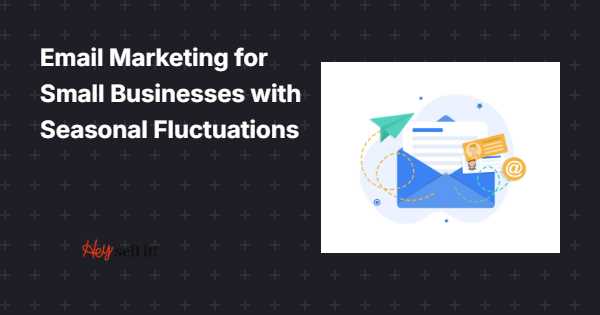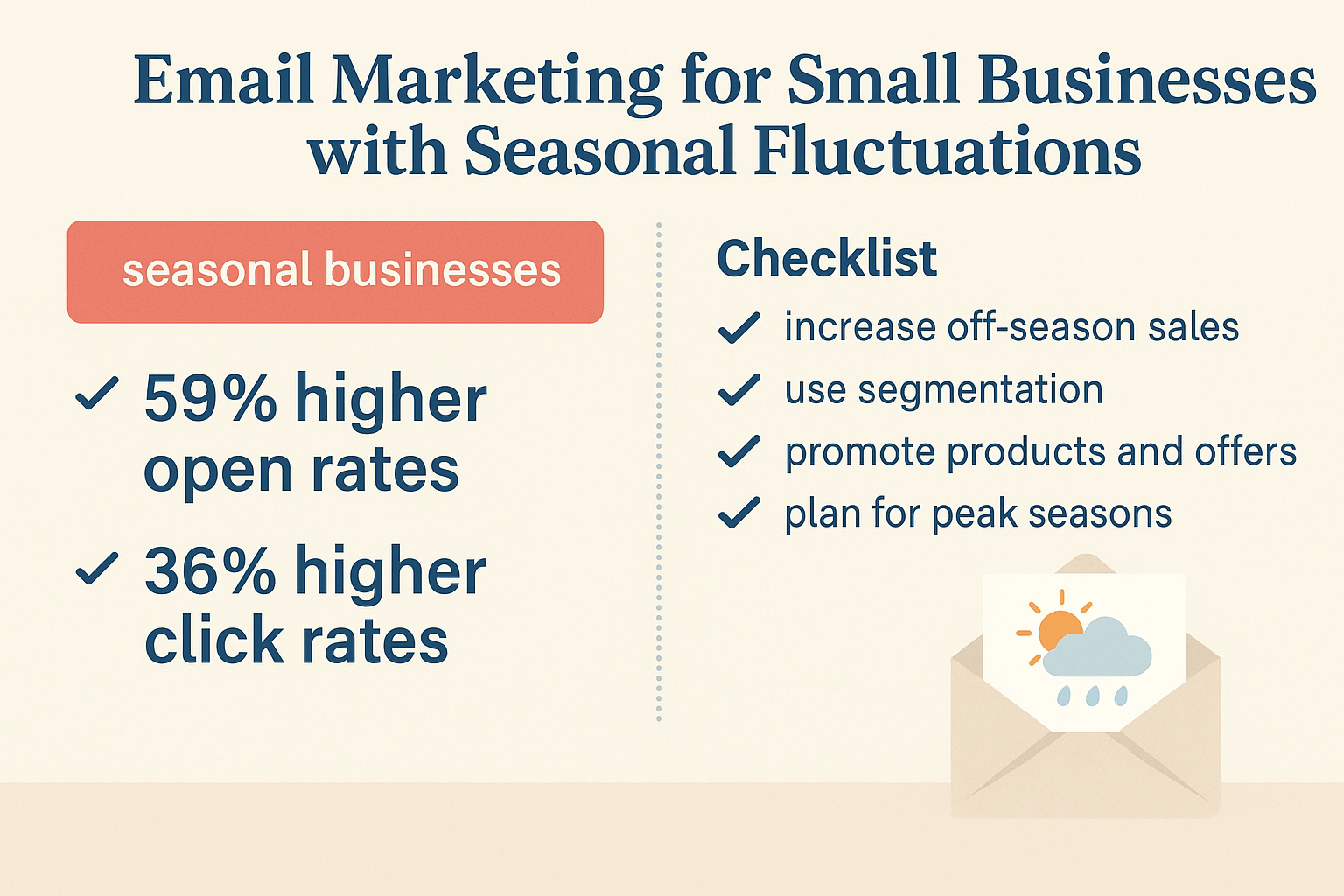Abdullah Usman
You’re running a beachside ice cream shop, and it’s January. Your foot traffic has dropped to nearly zero, but your inbox is about to become your most powerful sales weapon. While most seasonal business owners panic during off-peak months, smart entrepreneurs leverage email marketing to maintain customer relationships and generate consistent revenue throughout the year.
As someone who’s spent eight years helping businesses optimize their digital presence through comprehensive SEO services, I’ve witnessed firsthand how seasonal fluctuations can make or break small businesses. The difference between thriving year-round and barely surviving off-season often comes down to one crucial factor: strategic email marketing.
Why Do Seasonal Businesses Struggle with Email Marketing?
Most seasonal business owners treat email marketing like their business operations – they ramp up during peak season and go silent during slow periods. This approach is fundamentally flawed and costs businesses millions in lost revenue annually.
Research from Campaign Monitor shows that segmented email campaigns generate 760% more revenue than non-segmented campaigns. For seasonal businesses, this statistic becomes even more critical because your audience’s needs and purchasing behaviors shift dramatically throughout the year.
The core challenge lies in understanding that your customers don’t disappear during off-season – their interests and pain points simply evolve. A ski resort’s email list doesn’t become worthless in summer; those subscribers become potential customers for hiking tours, mountain biking, or wedding venues.
How Can You Build an Email List That Survives Seasonal Changes?
Building a resilient email list requires the same strategic thinking that drives effective ecommerce SEO – understanding your audience’s journey throughout the entire year, not just during peak seasons.
Start by implementing lead magnets that provide value beyond your primary seasonal offering. A Christmas decoration store shouldn’t just offer “10% off ornaments” in July. Instead, create year-round valuable content like “Home Decorating Tips for Every Season” or “DIY Holiday Crafts Your Kids Will Love.”
Your website’s on-page SEO should support this strategy by creating content hubs that attract visitors year-round. When someone searches for “summer patio decorating ideas,” your Christmas store can capture that lead and nurture them until December arrives.
Consider implementing progressive profiling in your email signup forms. Instead of asking for just name and email, gradually collect information about preferences, purchase history, and seasonal interests. This data becomes invaluable for creating targeted campaigns that resonate regardless of the season.
What Email Strategies Work Best During Peak Season?
Peak season is when your email marketing should shift into high gear, but not in the way most businesses think. It’s not about sending more emails – it’s about sending smarter emails that capitalize on heightened buying intent.
During peak season, your email frequency can increase by 40-50% without significantly impacting unsubscribe rates, according to data from Mailchimp. However, this increased frequency must be matched with increased value and relevance.
Implement countdown timers for limited-time offers, showcase real-time inventory updates, and create urgency through scarcity messaging. A local landscaping company might send daily emails during spring featuring “Today’s Featured Plant” with limited quantities available.
Your email content should mirror your semantic SEO strategy – focus on long-tail keywords and specific customer intents. Instead of generic “Spring Sale” subject lines, use specific benefits like “Get Your Garden Ready for Spring Entertaining Season.”
Personalization becomes crucial during peak season. Segment your list based on previous purchase behavior, geographic location, and engagement patterns. A beachfront restaurant should send different emails to locals versus tourists, focusing on regular dining versus special vacation experiences.
How Do You Maintain Engagement During Off-Peak Periods?
The off-season is where email marketing truly proves its worth for seasonal businesses. This is when you transform from a transactional relationship to a trusted advisor in your customers’ lives.
Educational content becomes your primary weapon during slow periods. A pool maintenance company can send weekly emails about home improvement projects, lawn care tips, or seasonal home maintenance checklists. This content serves dual purposes: maintaining brand awareness and supporting your local SEO efforts through increased website traffic and engagement.
Create seasonal content calendars that align with your customers’ year-round interests. A tax preparation service can send monthly financial tips, budgeting advice, and investment insights throughout the year, positioning themselves as year-round financial advisors rather than seasonal service providers.
User-generated content campaigns work exceptionally well during off-seasons. Encourage customers to share photos and stories from their peak season experiences. A summer camp can showcase camper photos and testimonials throughout the winter, building excitement for the next season while maintaining engagement.
What Role Does Segmentation Play in Seasonal Email Marketing?
Segmentation for seasonal businesses requires a more nuanced approach than traditional year-round businesses. You’re not just segmenting by demographics or purchase history – you’re segmenting by seasonal behavior patterns and lifecycle stages.
Create segments based on seasonal engagement patterns. Identify your “early birds” who engage with seasonal content months in advance, your “peak performers” who are most active during your busy season, and your “late bloomers” who make purchases toward the end of your season.
Geographic segmentation becomes particularly important for seasonal businesses. A lawn care company operating in multiple climate zones should send different emails to customers in Florida versus Minnesota, adjusting timing and content based on local seasonal patterns.
Your SEO audit process should inform your email segmentation strategy. Analyze which seasonal keywords drive the most valuable traffic to your website, then create email segments targeting customers who showed interest in those specific topics.
How Can You Automate Email Sequences for Seasonal Success?
Automation is where seasonal email marketing transforms from a time-consuming task into a revenue-generating machine. The key is building sequences that adapt to seasonal cycles while maintaining personal relevance.
Create welcome series that introduce new subscribers to your full range of seasonal offerings. A wedding venue might have a 12-email welcome series showcasing different seasonal wedding themes, vendor partnerships, and planning timelines.
Implement re-engagement campaigns triggered by seasonal behavior changes. If a customer who typically opens summer-themed emails suddenly stops engaging, trigger a personalized sequence asking about their interests and offering relevant content.
Your Shopify SEO strategy should integrate with your email automation. Use product view and cart abandonment data to trigger seasonal emails that address specific customer interests and shopping behaviors.
Develop seasonal transition sequences that bridge the gap between your peak and off-peak periods. A Christmas tree farm might send a series about Christmas in July celebrations, summer decorating with evergreens, or planning next year’s perfect Christmas.
What Metrics Should You Track for Seasonal Email Campaigns?
Seasonal businesses need to track metrics differently than year-round operations. Your success isn’t just measured by monthly performance – it’s measured by year-over-year growth and seasonal trend analysis.
Track seasonal CLV (Customer Lifetime Value) separately from overall CLV. Understanding how much revenue a customer generates across multiple seasons helps you invest appropriately in retention efforts during off-peak periods.
Monitor engagement patterns across seasonal cycles. A customer who opens 80% of emails during peak season but only 20% during off-season isn’t disengaged – they’re showing normal seasonal behavior patterns.
Your email metrics should complement your local SEO performance data. Track how email campaigns drive website traffic, improve search rankings for seasonal keywords, and contribute to overall digital marketing ROI.
Why Should You Integrate Email Marketing with Your SEO Strategy?
Email marketing and SEO aren’t separate strategies – they’re complementary forces that amplify each other’s effectiveness. Your email content should drive traffic to optimized landing pages, while your SEO insights should inform email content creation.
Use email campaigns to promote seasonal blog content that supports your SEO efforts. A landscaping company’s email about “Spring Lawn Care Essentials” should link to an optimized blog post targeting relevant seasonal keywords.
Your email list becomes a powerful tool for testing SEO content ideas. Send surveys asking about seasonal pain points and interests, then create content targeting those specific needs and keywords.
Email marketing data provides valuable insights for your SEO audit process. Track which email topics generate the most website traffic and engagement, then prioritize those topics in your content marketing strategy.
Action Points for Implementing Seasonal Email Marketing
Start by conducting a seasonal customer journey analysis. Map out your customers’ needs, interests, and pain points throughout the entire year, not just during your peak season.
Create a 12-month email content calendar that balances promotional content with educational value. Aim for a 70/30 split between valuable content and promotional messages during off-peak periods.
Implement advanced segmentation based on seasonal behavior patterns, purchase history, and engagement levels. Your email platform should reflect the same level of sophistication as your ecommerce SEO strategy.
Develop automated email sequences for each stage of the seasonal customer lifecycle – from initial awareness through peak season purchase and off-season retention.
Set up comprehensive tracking systems that measure both immediate campaign performance and long-term seasonal trends. Your email metrics should inform your broader digital marketing strategy.
Your Next Steps Toward Year-Round Email Marketing Success
Seasonal fluctuations don’t have to mean revenue rollercoasters. With strategic email marketing, you can maintain customer relationships, generate off-season revenue, and build a more sustainable business model.
Remember that email marketing success for seasonal businesses isn’t about sending more emails – it’s about sending smarter, more relevant emails that provide value throughout the entire customer lifecycle. Your email strategy should complement your SEO services approach, creating a cohesive digital marketing ecosystem that drives results year-round.
The businesses that thrive despite seasonal challenges are those that view email marketing as an essential utility, not a seasonal accessory. Start implementing these strategies today, and watch your off-season become your secret competitive advantage.
Ready to transform your seasonal business into a year-round revenue generator? Your email list is waiting to become your most valuable asset.


